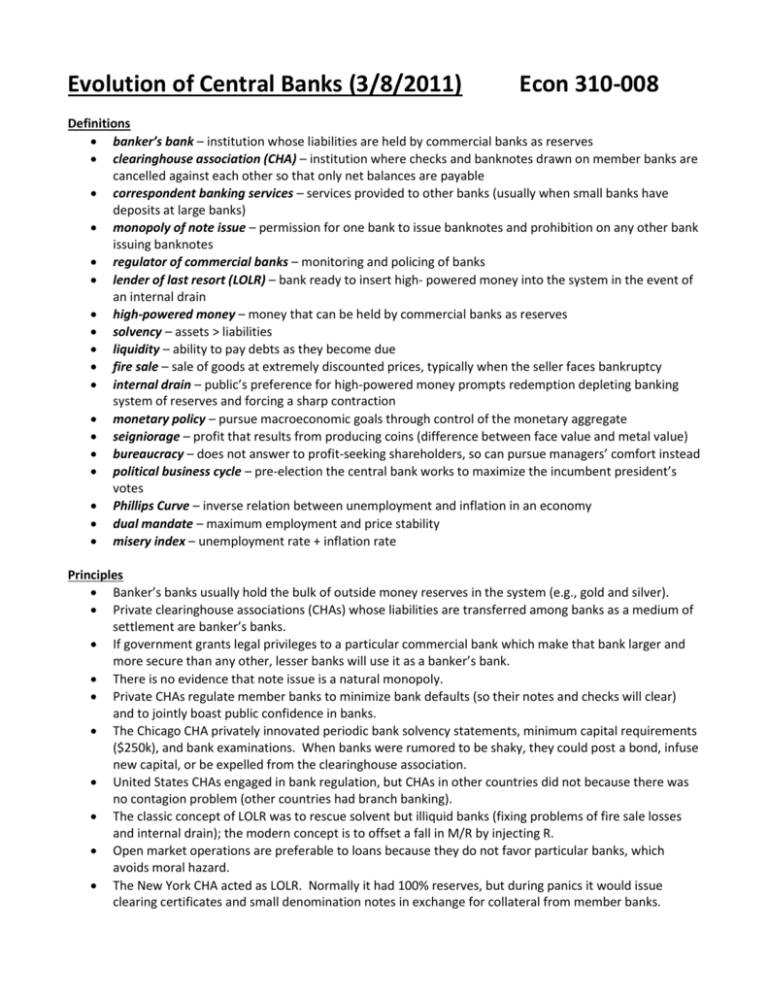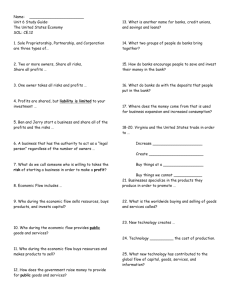Word Document
advertisement

Evolution of Central Banks (3/8/2011) Econ 310-008 Definitions banker’s bank – institution whose liabilities are held by commercial banks as reserves clearinghouse association (CHA) – institution where checks and banknotes drawn on member banks are cancelled against each other so that only net balances are payable correspondent banking services – services provided to other banks (usually when small banks have deposits at large banks) monopoly of note issue – permission for one bank to issue banknotes and prohibition on any other bank issuing banknotes regulator of commercial banks – monitoring and policing of banks lender of last resort (LOLR) – bank ready to insert high- powered money into the system in the event of an internal drain high-powered money – money that can be held by commercial banks as reserves solvency – assets > liabilities liquidity – ability to pay debts as they become due fire sale – sale of goods at extremely discounted prices, typically when the seller faces bankruptcy internal drain – public’s preference for high-powered money prompts redemption depleting banking system of reserves and forcing a sharp contraction monetary policy – pursue macroeconomic goals through control of the monetary aggregate seigniorage – profit that results from producing coins (difference between face value and metal value) bureaucracy – does not answer to profit-seeking shareholders, so can pursue managers’ comfort instead political business cycle – pre-election the central bank works to maximize the incumbent president’s votes Phillips Curve – inverse relation between unemployment and inflation in an economy dual mandate – maximum employment and price stability misery index – unemployment rate + inflation rate Principles Banker’s banks usually hold the bulk of outside money reserves in the system (e.g., gold and silver). Private clearinghouse associations (CHAs) whose liabilities are transferred among banks as a medium of settlement are banker’s banks. If government grants legal privileges to a particular commercial bank which make that bank larger and more secure than any other, lesser banks will use it as a banker’s bank. There is no evidence that note issue is a natural monopoly. Private CHAs regulate member banks to minimize bank defaults (so their notes and checks will clear) and to jointly boast public confidence in banks. The Chicago CHA privately innovated periodic bank solvency statements, minimum capital requirements ($250k), and bank examinations. When banks were rumored to be shaky, they could post a bond, infuse new capital, or be expelled from the clearinghouse association. United States CHAs engaged in bank regulation, but CHAs in other countries did not because there was no contagion problem (other countries had branch banking). The classic concept of LOLR was to rescue solvent but illiquid banks (fixing problems of fire sale losses and internal drain); the modern concept is to offset a fall in M/R by injecting R. Open market operations are preferable to loans because they do not favor particular banks, which avoids moral hazard. The New York CHA acted as LOLR. Normally it had 100% reserves, but during panics it would issue clearing certificates and small denomination notes in exchange for collateral from member banks. The short run Phillips Curve is downward sloping, but the long run Phillips Curve is vertical at the natural rate of unemployment. Political business cycle: Move along Phillips Curve to best short run attainable inflation and unemployment combination on the day of the election (reduce inflation with monetary contraction long before the election, then reduce unemployment with monetary expansion right before the election). President Nixon pressured Federal Reserve chairman Arthur Burns to pursue an expansionary monetary policy for the 1972 election. Roles of a central bank banker's bank monopoly of note issue regulator of commercial banks lender of last resort monetary policy Bagehot’s prescription for LOLR 1. lend freely to qualifying banks save banks worth saving 2. announce #1 in advance allay fearful reserve demands 3. bank needs good collateral don’t support insolvent banks 4. lend at a penalty interest rate reduce moral hazard Fed has violated #3 and #4 Scotland 1695 – Bank of Scotland chartered 1707 – Union of the Parliaments 1716 – BoS monopoly expired 1727 – Royal Bank of Scotland chartered 1769 – 32 banks of issue o shake-out with Ayr failure o leading role by BoS, RBS, BLC 1810 – 25 banks; CBS (large joint-stock bank) entered 1844 – 19 banks; Peel’s Act froze entry Objectives of a central bank seigniorage (inflation) bureaucratic political business cycles macroeconomic policy Origins of Central Banks Bank of England o legal privileges Federal Reserve System (USA) o nationalizing CHA functions Bank of Canada o monetary policy Bank of France, Bank of Italy o fiscal motive (seigniorage) Incentives for inflation seigniorage (revenue) reduction in real debt bracket creep (tax brackets) short term macroeconomics o reduction of interest rates o reduction of unemployment Bank of England 1694 – founded 1697 – charter made exclusive 1708 – six-partner rule, note monopoly in London 1833 – BOE notes legal reserves for other banks 1844 – Peel’s Act o no new note issue banks o froze existing note issue o $14m for BoE w/o reserve o >$14m 100% gold reserve Bureaucratic scapegoating o blame for macro outcomes o long terms in office o budgetary autonomy budget padding o higher salaries o plusher offices o larger travel budgets o vanity publications o more employees revolving door o profit for bond dealers o high paid Fed watchers







